Burengiin Nuruu Mountain Range

History of the Peace Corps Program in Mongolia
Country Assignment
- Country: Mongolia (Outter)
- Program: Youth Development
- Job Title: Life Skills Trainer (also: English teacher, Child Caretaker, Fund Raiser, Events Organizer, and IT Trainer)
- Orientation (Staging in Atlanta, GA): May 31-June 2, 2007
- Pre-Service Training (in Darkhan and Sukhbaatar, Mongolia): June 3-August 18, 2007
- Dates of Service (in Darkhan at Sun Children formerly "Asian Child Foundation" - a non-profit, non-government Japanese funded orphanage of 37 Mongolian children opened since 8/25/2005): August 19, 2007- August 18, 2009
Location and Nature of the Job
CYD Volunteers are placed in provincial centers with population between 15,000 and 70,000. A few CYD Volunteers are placed in Ulaanbaatar, where the population is reaching 1 million. I will work with youth-focused NGOs, children’s centers, schools, and civil society organizations to address major challenges confronting Mongolian youth today, such as education, life skills, employability, and leadership. In addition, the work will involve workshops and presentations at schools and community agencies and will entail traveling to other outlying communities that have less access to information and training. Given the vast distances in Mongolia, these visits will often require overnight stays.
Saturday, July 28, 2007
Religion: Buddhism and Visit to the Buddhist Monastery, Амарбаясгалант Хийд
As a part of Cross-Culture Training for PST, all three host community groups had a schedule visit to Amarbayasgalant Khiid (Амарбаясгалант Хийд), one of the top three Buddhist monasteries in Mongolia. Amarbayasgalant Khiid was originally built between 1727 and 1737 by the Manchu emperor Yongzheng and dedicated to the Mongolian Buddhist Zanabazar, whose mummified body was later moved there in 1779. While touring the monastery grounds (27 temples and statues, though only five temples are open to tourists), I couldn’t help but noticed how similar the architecture was to Gyeongbokgung, the main palace of the Joseon Dynasty in Seoul, Korea. From the symmetrical layout to the imperial color scheme, the architecture was distinctively Chinese. I later found out that the monastery was built according to the Manchu style. My earlier thought makes sense given that both Mongolia and South Korea were influenced by the Chinese.
The history of Buddhism has a difficult past in Mongolian history. In 1924, when Bogd Khaan – the 8th Jebtzun Damba (reincarnated spiritual leader of Mongolia) – died, the then communist government prevented a successor from being found. The years of repression that followed peaked in the spring of 1937 when the government ordered the army to destroy religion. The obliteration that followed resulted in 700 monasteries being destroyed and 17,000 monks arrested, never to be seen again. Freedom of religion would not be restored until the democracy movement in 1990, 53 long years later.
Today, around 80% of Mongolians claim to be Buddhist of the Mahayana variety as practiced in Tibet (popularly known as Tibetan Buddhism). However, as culturally observed by curious PCTs, Mongolians tend not to be the practicing kind. In the northern aimags of Khentii, Selenge, Bulgan and Khovsgol, the Buddhism that is practiced is mixed with elements of Shamanism. This is largely because during the time of religious oppression, Shamanism survived because there were no books or buildings to destroy. And later on, with the installation of religious freedom, it co-existed in within the mix of Buddhism.
Two to three generations of Mongolians grew up without Buddhism. Maybe the reason why Mongolians identify themselves as Buddhist even though they don’t practice is because most people no longer understand the Buddhist rituals or their meanings, and the current standing monasteries in Mongolia suffer from a chronic lack of trained Buddhist lamas.
Recommended Books on Mongolia
- “Dateline: An American Journalist in Nomad’s Land” by Michael Kohn, 2006.
- "Ghengis Khan and the Making of the Modern World” by Jack Weatherford, 2004.
- “Riding Windhorses” by Sarangerel, 2000.
- “Twentieth Century Mongolia” by Baabar, 1999.
Recommended Mongolian Movies
- The Story of the Weeping Camel (2004), Die Geschichte vom Weinenden Kamel
- Mongolian Ping Pong (2005), Lü cao di
Notable Articles on Mongolia
Informational Links
- Peace Corps - Mongolia
- International Calling Card (Cheap!)
- Current Mongolian News
- Current Weather Conditions in Ulannbaatar, Mongolia
- A Tour of Mongolia Through Photography
- History of Mongolia
- Mongolian Culture
- Mongolian Lanuage
- Weather and Climate In Mongolia
- Travel Guide to Mongolia
- Official Tourism Website of Mongolia
- Asia.com - Cheapest Airfare to Asia
- MIAT - Mongolian Airlines
- Currency Converter
- Entry and Visa Requirements










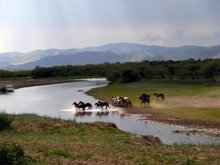
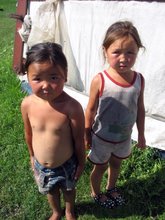
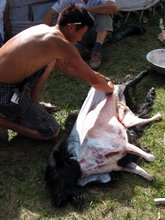
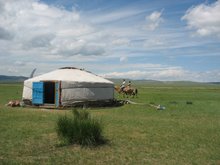

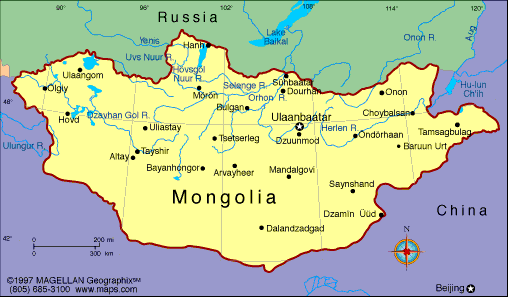
No comments:
Post a Comment